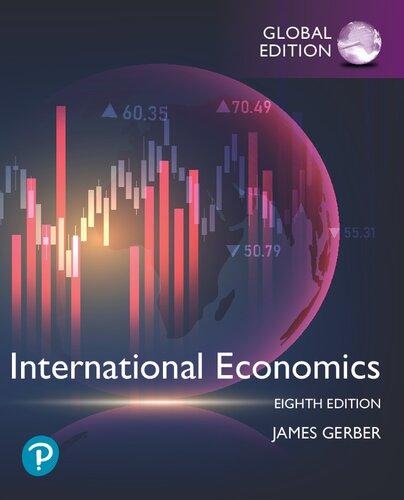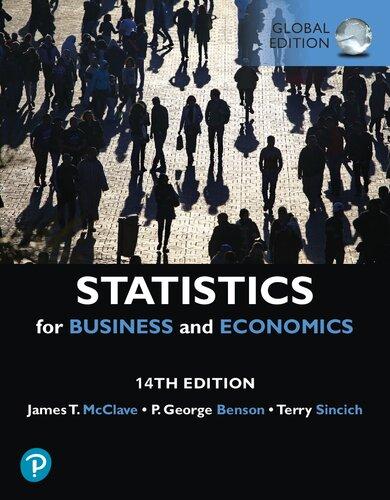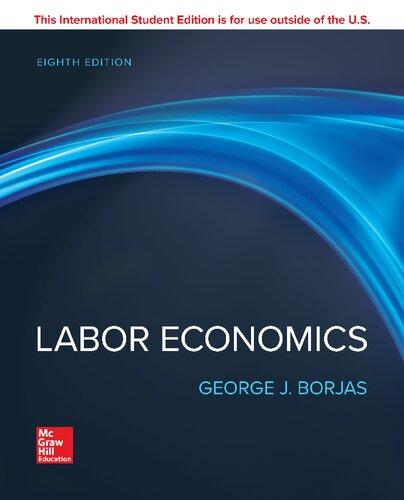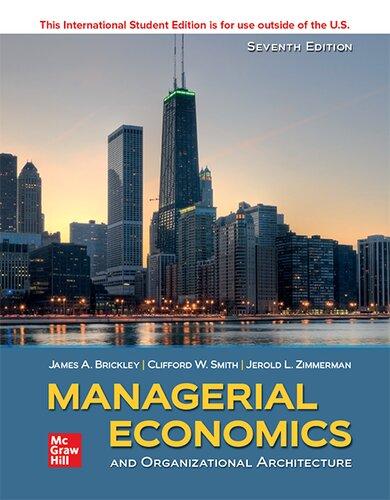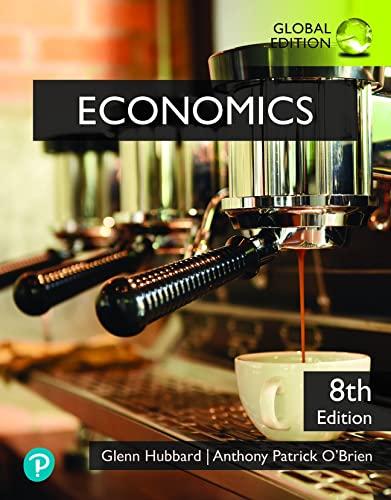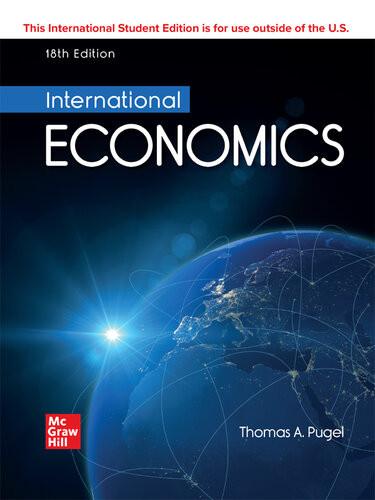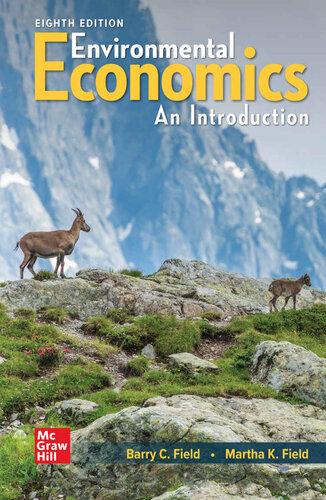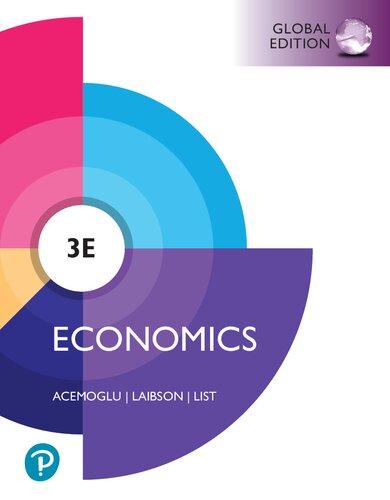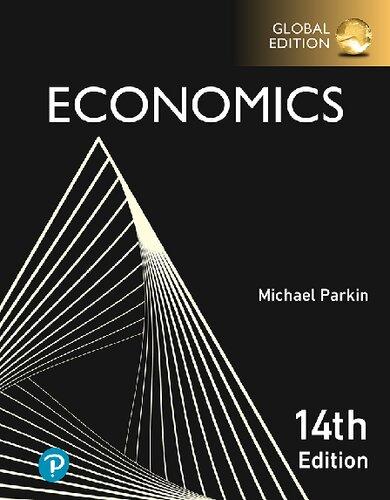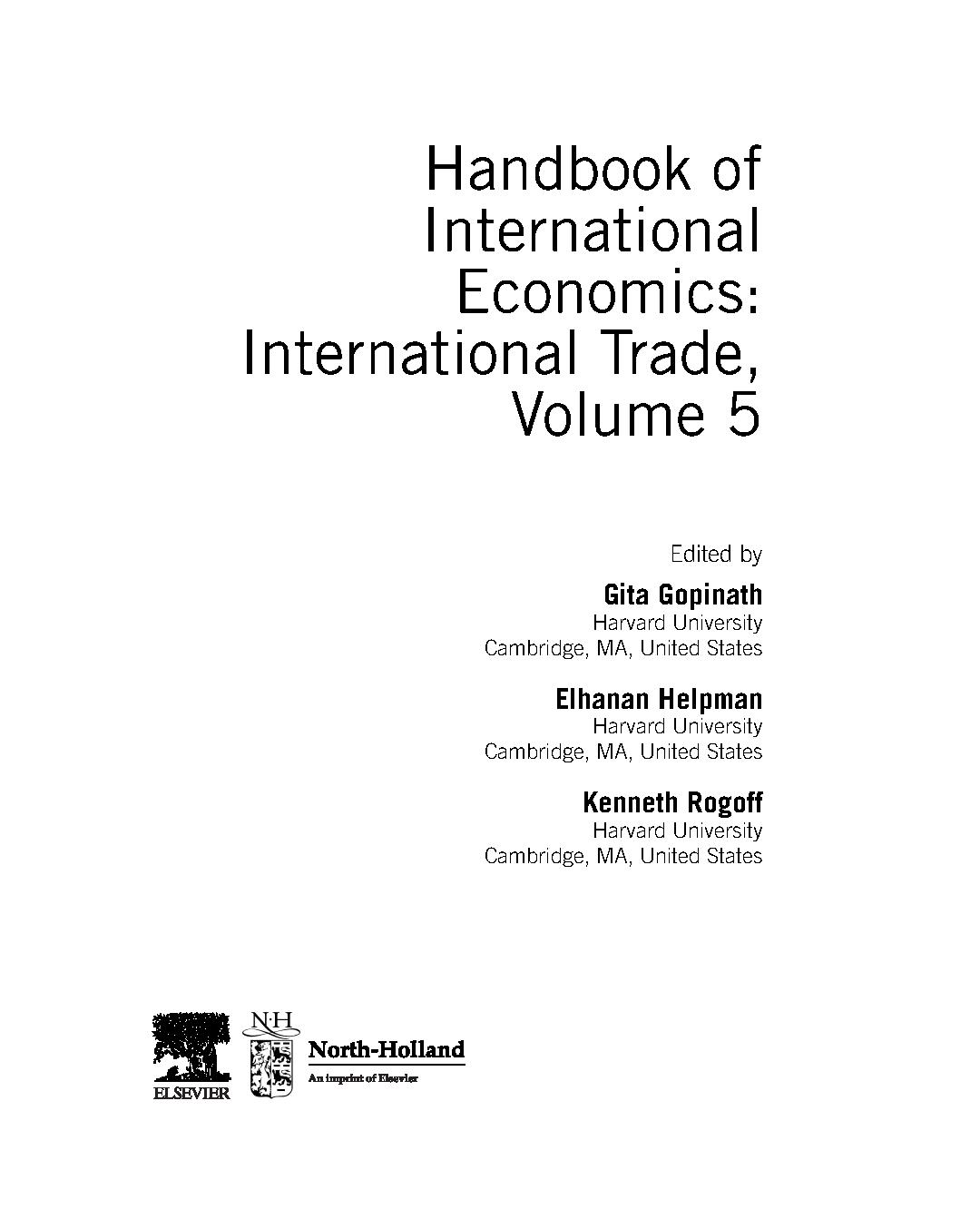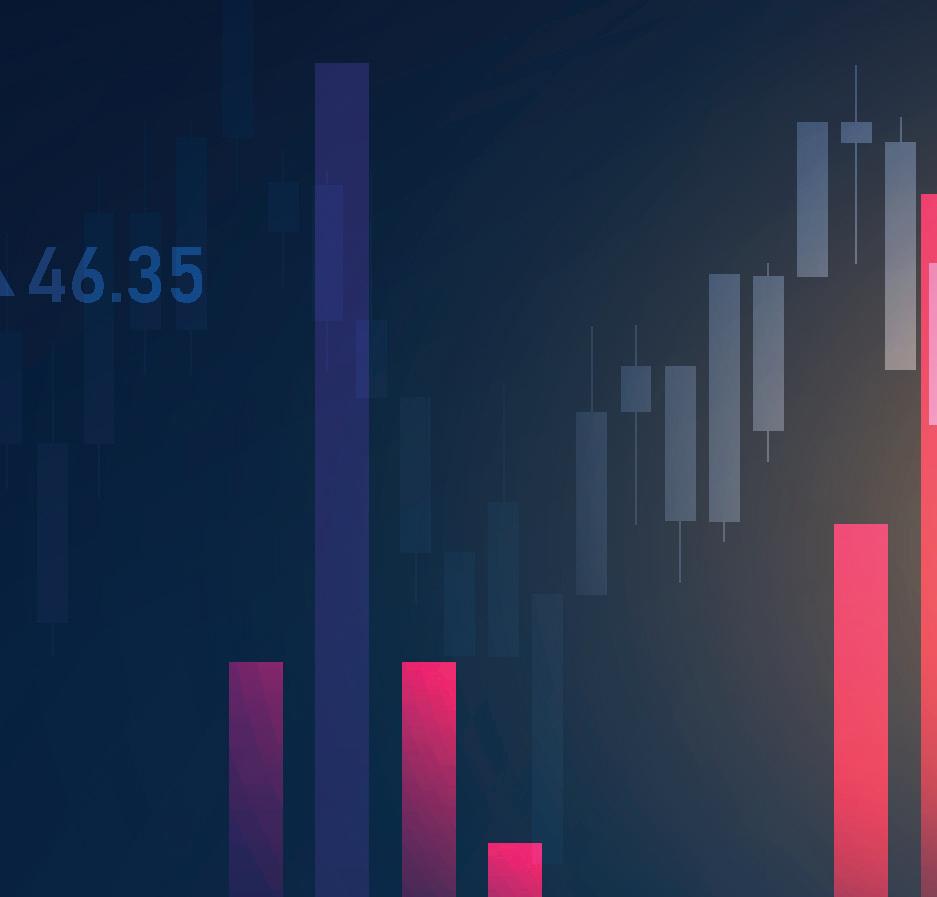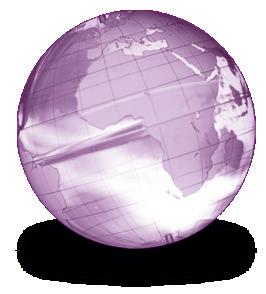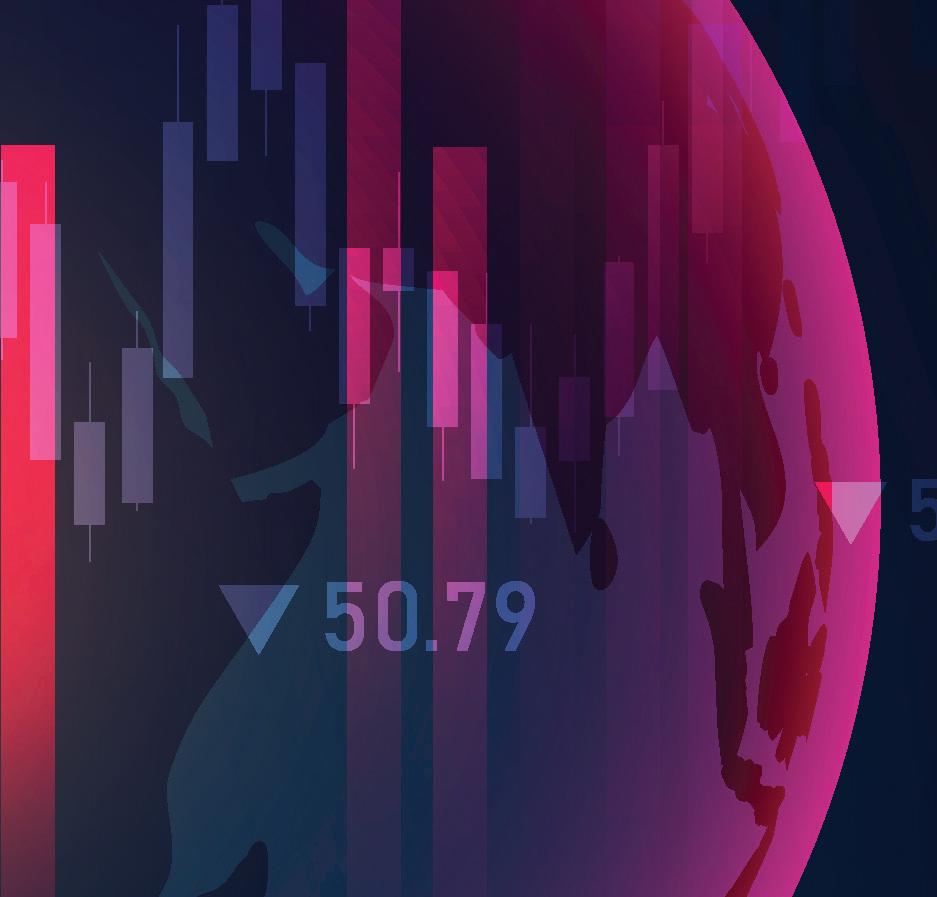PREFACE
International Economics is designed for a one-semester course covering both the trade and finance components of international economics. The Eighth Edition continues the approach of the first seven editions by offering a principles-level introduction to core theories together with policy analysis and the institutional and historical contexts of international economic relations. My goal is to make economic reasoning about the international economy accessible to a diverse group of students, including both economics majors and nonmajors. My intention is to present the consensus of economic opinion, when one exists, and to describe the differences when one does not. In general, however, economists are more often in agreement than not.
What’s New in the Eighth Edition
This Eighth Edition of International Economics preserves the organization and coverage of the Seventh Edition and adds several updates and enhancements. New to this edition:
■ Five new case studies cover Mexico’s participation in global value chains, the collapse of Thailand’s currency in 1997–98, the North American automotive value chain, North American trade through the lens of the gravity model of trade, and the United Kingdom’s exit from the European Union.
■ The growth of protectionism is woven into the discussion of trade policies throughout the book.
■ The gravity model of trade has a more complete presentation.
■ Global value chains are introduced in the section on off-shoring.
■ The national security argument for protection is discussed, along with the challenges it poses for the World Trade Organization.
■ All tables and graphs have been updated.
Notable Content Changes
■ Chapter 1’s minor revisions begin the discussion of the recently protectionist direction in U.S. trade policy. While it is uncertain if this is a permanent or temporary shift away from multilateral agreements and increasing openness,
it is an expression of the concerns about globalization and international trade that are felt by many people around the world.
■ Chapter 2 changes reflect the discussion begun in Chapter 1 by adding an overview of the views of the opponents to regional trade agreements. Their concerns are presented in terms of jobs, industries, and communities.
■ Chapter 3 changes continue the discussion by highlighting and contrasting the views of trade economists with the objections of protectionist interests. The idea of gains from trade is emphasized and differentiated from the notion that every individual benefits from trade. The chapter points out the complexity and uncertainty of disentangling the trade effects from those caused by new communication, transportation, and information technologies.
■ Chapter 4 incorporates a discussion of the gravity model of trade. The gravity model is presented as the most accurate model for predicting trade flows between countries but is silent on the issue of the specific goods and services traded and on the determinants of comparative advantage. The section on outsourcing and off-shoring is rewritten to emphasize the role of global value chains (GVCs) and is followed up with a new case study on Mexico’s participation in GVCs.
■ Chapter 5 has minor changes that refocus the case study on the WTO and industrial policies in order to ask whether WTO rules prohibit the use of industrial policies.
■ Chapters 6 and 7 on commercial policy describe the problems created when tariffs are applied to intermediate goods. They also discuss how the disconnect between wages and labor productivity reduces the bargaining power of workers and alters the labor argument for protection. Chapter 7 explains in more detail the problems associated with the national security argument for protection and has a new case study that addresses the WTO’s rules for using national security as a reason for increased tariffs.
■ Chapter 8 adopts the position that labor and environmental standards have become a part of many new trade agreements and are here to stay. Since the efficacy of labor and environmental clauses in trade agreements is uncertain, alternatives to trade measures are still worth considering.
■ Chapter 9 retains most of the content from the previous edition. Given the current rhetoric about U.S. trade deficits, it is worth emphasizing the section that reviews the causes of current account deficits and the case study of the U.S. deficit.
■ Changes to Chapter 10 are mostly in its organization and a new case study. Fixed exchange rates, including the gold standard, are discussed directly after the section on flexible rates and before discussion of the real exchange rate. A new case study on the collapse of Thailand’s currency in 1997–98 comes directly after the section on real rates.
■ A very minor change to Chapter 11 introduces the change in U.S. and European central bank policies that have enabled them to expand the types of assets they purchase.
■ Chapter 12 adds the concept of balance of payments crises to its list and introduces the concept of asymmetric information in the section on moral hazard and financial regulation. In addition, the case study on the Asian Crisis of 1997–98 is condensed.
■ Chapter 13 has major changes given the sudden redirection of U.S. trade policy. These changes emphasize the challenges to the United States stemming from the growth and development of the Chinese economy and the U.S. shift toward unilateral trade actions. The focus on the NAFTA model is retained since it is the basis for most subsequent U.S. trade agreements even as it is replaced by the United States-Mexico-Canada Agreement (USMCA). A new case study on the North American automotive value chain replaces the earlier study on Mexico’s collective agriculture. The distinction between trade preference programs, trade initiatives, and bilateral or plurilateral trade agreements is clarified and strengthened, and a new case study uses the gravity model to discuss North American trade.
■ Chapter 14 takes into account the departure of the United Kingdom from the European Union with a new case study on the subject. It also improves the discussion of EU institutions. The final section adds a discussion of the challenge to the EU to find new institutional mechanisms for risk sharing across the region.
■ All relevant economic data are made current and up to date for Chapters 15 and 16.
■ Chapter 17 highlights the advances of India and China and notes the growing conflict between China and high-income economies. It has added material on China’s Made in China 2025 initiative and its Belt and Road Initiative. The problems for trade rules created by the extensive use of state-owned enterprises are highlighted, as are intellectual property enforcement and the forced transfer of technology.
Flexibility of Organization
A text requires a fixed topical sequence because it must order the chapters one after another. This is a potential problem for some instructors, as there is a wide variety of preferences for the order in which topics are taught. The Eighth Edition, like the previous editions, strives for flexibility in allowing instructors to find their own preferred sequence.
■ Part 1 includes two introductory chapters that are designed to build vocabulary, develop historical perspective, and provide background information about the different international organizations and the roles they play in
the world economy. Some instructors prefer to delve into the theory chapters immediately, reserving this material for later in the course. There is no loss of continuity with this approach.
■ Part 2 presents the trade and commercial policy side of international economics. Part 2 can be taught before or after Part 3, which covers international finance. Part 2 includes six chapters that cover trade models (Chapters 3–5) and commercial policy (Chapters 6–8). A condensed treatment of this section could focus on the Ricardian model in Chapter 3 and the analysis of tariffs and quotas in Chapters 6 and 7. Chapter 8 on labor and environmental standards can stand on its own, although the preceding chapters deepen student understanding of the trade-offs.
■ Part 3 covers international finance. It begins with a discussion of the balance of payments that is followed by chapters on exchange rates, open economy macroeconomics, and financial crises. Chapter 11 on open economy macroeconomics is optional. It is intended for students and instructors who want a review of macroeconomics, including the concepts of fiscal and monetary policy, in a context that includes current accounts and exchange rates. If Chapter 11 is omitted, Chapter 12 (financial crises) remains accessible as long as students have an understanding of the basic concepts of fiscal and monetary policy. Chapter 12 relies most heavily on Chapters 9 (balance of payments) and 10 (exchange rates and exchange rate systems).
■ Part 4 presents five chapters, each focused on a geographic area. These chapters use theory presented in Chapters 3–12 in a similar fashion to the economics discussion that students find in the business press, congressional testimonies, speeches, and other sources intended for a broad civic audience. Where necessary, concepts such as the real rate of exchange are briefly reviewed. One or more of these chapters can be moved forward to fit the needs of a particular course.
Solving Teaching and Learning Challenges
Teaching and learning international economics has a number of inherent challenges. In a one-semester course, instructors must carefully choose the material they will cover and what they will omit. Meanwhile, students frequently experience international economics as overly theoretical and too abstract. These were two of the main concerns that led to the development of this text. In addition, the rapidly evolving international economy has led to the creation of global value chains, surprisingly frequent financial crises, intense debates about trade, trade agreements, and migration, as well as many other new issues. Moved by these trends and their impacts, many non-economics students with limited background have signed up for introductory courses in international economics. This is an ongoing opportunity for teaching international economics to a wider audience, but it also poses challenges for the traditional course.
A Solid Foundation for International Economics
While writing the text and selecting topics to cover and to omit, I constantly asked what students need to know. A one-semester course must leave out many topics. My goal is to provide a solid foundation for advancing student interests and skills for further study and, if this is to be their only course in international economics, for guiding them to a level of competency and understanding of the many international forces around us.
Case Studies
One of the first choices in writing this book was to include several case studies in each chapter that highlight and build on the core theories and ideas. This allows students the opportunity to see theories in action and provides instructors with concrete examples of how theories can be used to analyze the forces behind everyday events.
International Economic Institutions
The positioning of the introduction to international institutions in Chapter 2 enables students to understand the goals of those institutions and the constraints they face. This is particularly useful when they encounter those and other institutions in subsequent chapters. Throughout the text, there is more coverage of historical and institutional details than is typical. As with Chapter 2, this helps illuminate the relationships among economic theory, economic policy, and economic events.
Five World Regions
Another atypical component of the text is the final section, Part 4. It is organized into five chapters, each focused on a different geographic area of the world. Instructors may choose to skip some or all of this material without loss of continuity, although many find it useful for highlighting economic theory in a real-world setting. Students will also find it useful for seeing the deployment of theory as a tool for understanding the challenges, opportunities, and actions of different national economies.
Vocabulary Checks and Study Questions
Each chapter has a set of five to seven learning objectives that are stated at the beginning and individually repeated after the subchapter heading where the objective is covered. This helps the students to learn in an organized and structured way. And finally, the end-of-the-chapter vocabulary and study questions are designed for students to test their understanding.
Real-World Career Skills
Students who work with this text on international economics will gain numerous career-building benefits.
Knowledge Application and Analysis
Students are exposed to a large number of new concepts and relationships that they must appropriately apply. This requires them to recall the material,
express it in their own words, and apply it to real-life situations. Application builds analytical skills, including the ability to break down concepts or ideas into component parts, and skills of synthesizing ideas to form new perspectives. Analysis also requires students to practice using their judgment to evaluate ideas and perspectives.
Critical Thinking
Critical thinking includes an understanding of the uses and limits of theory, but it also includes skills such as the ability to organize, synthesize, and analyze information. International economics is one of the subdisciplines of economics where the gap between expert opinion and the views of the general public is widest. Most of the propositions put forward by international economists are controversial with some groups or even the general public. Consequently, the ability to organize, synthesize, and analyze the arguments made and then to apply them to real-world conditions is an essential skill for mastering international economics.
Strengthened Numeracy
Numeracy is the ability to work with, interpret, and understand numbers. Those skills are directly covered in statistics and mathematical economics classes, but in order to strengthen their ability to work with data, most students need to experience numbers in their natural setting. The book offers many tables and graphs and a few equations that call for interpretation, analysis, and comparison. Students gain confidence and experience when they grapple with these types of real-world information.
Cultural Competency
The world is large, and there are many different ways that national economies exist in it. Throughout the text, there are examples drawn from a wide variety of countries. Part 4 delves more deeply into five specific world regions where students gain insight into the different ways countries solve the fundamental economic problem. These features widen student perspectives and prepare them for working in more diverse environments.
The Uses and Limits of Theories
Regardless of the career path a person takes, they need to understand the theories most relevant to their work because theories are usually the foundation for analysis and decision-making. All theories have limits, however, including the theories that form the field of international economics. It is important to know when conditions on the ground have exceeded the limits of theory. This text requires mastery of several theories, while the examination of specific conditions in countries and regions sometimes uncovers the limits of those theories. Throughout the text, the case studies, and examples drawn from actual historical conditions, help students practice applying theory and understanding their limits.
Supplementary Materials
For more information and resources, visit www.pearsonglobaleditions.com.
Acknowledgments
All texts are team efforts, even single-author texts. I owe a debt of gratitude to a large number of people. At San Diego State University, I have benefited from the opportunity to teach and converse with a wide range of students. My colleagues in San Diego and across the border in Mexico have been extremely helpful. Their comments and our conversations constantly push me to think about the core economic ideas that should be a part of a college student’s education and to search for ways to explain the relevance and importance of those ideas with greater clarity and precision. Any failure in this regard is, of course, mine alone.
I am deeply grateful to Samantha Lewis, Thomas Hayward, Neeraj Bhalla, Sugandh Juneja, Bhanuprakash Sherla, Allison Campbell, Gopala Krishnan Sankar, and the MyLab team.
Finally, my gratitude goes to the numerous reviewers who have played an essential role in the development of International Economics. Each of the following individuals reviewed the manuscript, many of them several times, and provided useful commentary. I cannot express how much the text has benefited from their comments.
Mary Acker, Iona College
Jeff Ankrom, Wittenberg University
David Aschauer, Bates College
H. Somnez Atesoglu, Clarkson University
Titus Awokuse, University of Delaware
Mohsen BahmaniOskooee, University of Wisconsin, Milwaukee
Richard T. Baillie, Michigan State University
Mina Baliamoune-Lutz, University of North Florida
Eugene Beaulieu, University of Calgary
Ted Black, Towson University
Bruce Blonigen, University of Oregon
Lee Bour, Florida State University
Byron Brown, Southern Oregon University
Laura Brown, University of Manitoba
Albert Callewaert, Walsh College
Tom Carter, Oklahoma City University
Srikanta Chatterjee, Massey University, New Zealand
Jen-Chi Cheng, Wichita State University
Don Clark, University of Tennessee
Raymond Cohn, Illinois State University
Peter Crabb, Northwest Nazarene University
David Crary, Eastern Michigan University
Al Culver, California State University, Chico
Joseph Daniels, Marquette University
Alan Deardorff, University of Michigan
Craig Depken II, University of North Carolina, Charlotte
John Devereaux, University of Miami
K. Doroodian, Ohio University
Carolyn Evans, Santa Clara University
Noel J. J. Farley, Bryn Mawr College
Ora Freedman, Stevenson University
Lewis R. Gale IV, University of Southwest Louisiana
Kevin Gallagher, Boston University
Ira Gang, Rutgers University
John Gilbert, Utah State University
James Giordano, Villanova University
Amy Jocelyn Glass, Texas A&M University
Joanne Gowa, Princeton University
Gregory Green, Idaho State University
Thomas Grennes, North Carolina State University
Winston Griffith, Bucknell University
Jane Hall, California State University, Fullerton
Seid Hassan, Murray State University
F. Steb Hipple, East Tennessee State University
Paul Jensen, Drexel University
Ghassan Karam, Pace University
George Karras, University of Illinois at Chicago
Kathy Kelly, University of Texas, Arlington
Abdul Khandker, University of Wisconsin, La Crosse
Jacqueline Khorassani, Marietta College
Sunghyun Henry Kim, Brandeis University
Vani Kotcherlakota, University of Nebraska at Kearney
Corrine Krupp, Michigan State University
Kishore Kulkarni, Metropolitan State College of Denver
Farrokh Langdana, Rutgers University
Daniel Y. Lee, Shippensburg University
Mary Lesser, Iona College
Benjamin H. Liebman, Saint Joseph’s University
Susan Linz, Michigan State University
Marc Lombard, Macquarie University, Australia
Thomas Lowinger, Washington State University
Nicolas Magud, University of Oregon
Bala Maniam, Sam Houston State University
Mary McGlasson, Arizona State University
Joseph McKinney, Baylor University
Judith McKinney, Hobart & William Smith Colleges
Howard McNier, San Francisco State University
Michael O. Moore, George Washington University
Stephan Norribin, Florida State University
William H. Phillips, University of South Carolina
Frank Raymond, Bellarmine University
Donald Richards, Indiana State University
John Robertson, University of Kentucky Community College System
Jeffrey Rosensweig, Emory University
Marina Rosser, James Madison University
Raj Roy, University of Toledo
Michael Ryan, Western Michigan University
George Samuels, Sam Houston State University
Craig Schulman, University of Arizona
William Seyfried, Winthrop University
Eckhard Siggel, Concordia University
David Spiro, Columbia University
Richard Sprinkle, University of Texas, El Paso
Ann Sternlicht, Virginia Commonwealth University
Leonie Stone, State University of New York at Geneseo
Carolyn Fabian Stumph, Indiana University,
Purdue University, Fort Wayne
Rebecca Summary, Southeast Missouri State University
Jack Suyderhoud, University of Hawaii
Kishor Thanawala, Villanova University
Henry Thompson, Auburn University
Cynthia Tori, Valdosta State University
Edward Tower, Duke University
Ross vanWassenhove, University of Houston
Jose Ventura, Sacred Heart University
Craig Walker, Oklahoma Baptist University
Michael Welker, Franciscan University
Jerry Wheat, Indiana State University
Laura Wolff, Southern Illinois University, Edwardsville
Chong K. Yip, Georgia State University
Alina Zapalska, Marshall University
Global Edition Acknowledgments
Pearson would like to thank the following people for contributing to and reviewing the Global Edition and sharing their insightful comments and suggestions:
Contributor
Gabriela Sterian, Romanian-American University
Reviewers
Jassem Alokla, University of Portsmouth
Merve Bernazoglu, Utrecht University
Natalie Chen, Warwick University
This page is intentionally left blank
An Introduction to the World Economy 1
Learning Objectives
After studying this chapter, students will be able to:
1.1 Discuss historical measures of international economic integration with data on trade, capital flows, and migration.
1.2 Compute the trade-to-GDP ratio and explain its significance.
1.3 Describe three factors in the world economy today that are different from the economy at the end of the first wave of globalization.
1.4 List the three types of evidence that trade supports economic growth.
1.5 Describe the employment possibilities and occupations open to students of international economics.
INTRODUCTION: INTERNATIONAL ECONOMIC INTEGRATION
In August 2007, a crisis erupted in the housing sector of the United States. At the time, few people realized that the subprime mortgage crisis would become a demonstration of international economic integration or that it would push the world economy to the brink of collapse. The crisis grew through the remainder of 2007 and into 2008, so that by the summer nearly all high-income economies were in deep distress. Contagion from the crisis spread like an epidemic as banks and other financial firms collapsed and solvent firms stopped lending. The scarcity of credit caused difficulties for businesses that could not find financing for their day-to-day operations, while, at the same time, consumers cut back on their spending and businesses cut back on new investment. By the end of 2008, economies around the world were in recession, with the notable exceptions of China, India, and the major oil producers.
In early 2020, another crisis, the deadly COVID-19 pandemic, caused national economies to suddenly shut down and severely disrupted the international flow of goods, services, and people. The effects are still developing as this text goes to print, but even though the pandemic has an entirely different origin than the financial crisis of 2007–09, both are examples of crises leading to severe economic recessions in many countries around the world. Both are extreme examples, but they are not unique. The Russian Crisis of 1998–99, the Asian Crisis of 1997–98, the Mexican Crisis of 1994–95, the Latin American Debt Crisis of 1982–89, and a number of others caused major
damage to financial systems, businesses, and households, both in the places where they originated and in many other countries.
The international integration of national economies has brought many benefits to nations across the globe, including technological innovation, less expensive products, and greater investment in regions where local capital is scarce, to name a few. But it has also made countries vulnerable to economic problems that have become more easily transmitted from one place to another. Given that the benefits and costs of international economic integration are surrounded by controversy, it is worth clarifying what we mean by the term international economic integration, or globalization in the economic sphere. To help us understand these forces better, a historical perspective is also useful.
ELEMENTS OF INTERNATIONAL ECONOMIC INTEGRATION
LO 1.1 Discuss historical measures of international economic integration with data on trade, capital flows, and migration.
LO 1.2 Compute the trade-to-GDP ratio and explain its significance.
LO 1.3 Describe three factors in the world economy today that are different from the economy at the end of the first wave of globalization.
LO 1.4 List the three types of evidence that trade supports economic growth.
Most people would agree that the major economies of the world are more integrated than at any time in history. Given our instantaneous communications, modern transportation, and relatively open trading systems, most goods can move from one country to another without major obstacles and at relatively low cost. For example, most cars today are made in fifteen or more countries after you consider where each part is made, where the advertising originates, who does the accounting, and who transports the components and the final product. Nevertheless, the proposition that today’s economies are more integrated than at any other time in history is not simple to demonstrate. It is clear that our current wave of economic integration began in the 1950s, with the reduction of trade barriers after World War II. In the 1970s, many countries began to encourage financial integration by increasing the openness of their capital markets. The advent of the Internet in the 1990s, along with the other elements of the telecommunications revolution, pushed economic integration to new levels as multinational firms developed international production networks and markets became ever more tightly linked.
Today’s global economy is not the first instance of a dramatic growth in economic ties between nations, however, as there was another important period between approximately 1870 and 1913. New technologies such as transatlantic cables, steam-powered ships, railroads, and many others led the way, much as
they do today. For example, when the first permanent transatlantic cable was completed in 1866, the time it took for a New York businessperson to complete a financial transaction in London fell from approximately three weeks to one day, and by 1914 it had fallen to one minute as radio telephony became possible.
We have mostly forgotten about this earlier period of economic integration, and that makes it easier to overestimate integration today. Instantaneous communications and rapid transportation, together with the easy availability of foreign products, often cause us to lose sight of the fact that most of what we buy and sell never makes it out of our local or national markets. We rarely pause to think that haircuts, restaurant meals, gardens, health care, education, utilities, and many other goods and services are partially or wholly domestic products. In the United States, for example, about 83.4 percent of goods and services are produced domestically, with imports (16.6 percent) making up the remainder of what we consume (2014). By comparison, in 1890 the United States made about 92 percent of its goods and services, a larger share than today but not radically different.
The question as to whether we are more economically integrated today or during some period in the past is not academic. Between the onset of World War I in 1914 and the end of World War II in 1945, the world economy suffered a series of human-made catastrophes that de-integrated national economies. Two world wars and a global depression caused most countries to close their borders to foreign goods, foreign capital, and foreign people. Since the end of World War II, many of the economic linkages between nations have served to repair the damage done during the first half of the twentieth century, but there is no reason to think that events might not cause a similar decoupling in the future.
Understanding international economic integration requires us to define what we mean by the term. Economists usually point to four criteria or measures for judging the degree of integration, which are trade flows, capital flows, people flows, and the similarity of prices in separate markets. The first three points are relatively self-explanatory, while the similarity of prices refers to the fact that integrated economies have price differences that are relatively small and are due mainly to differences in transportation costs. Goods that can move freely from a low-cost to a high-cost region should experience price convergence as goods move from where they are plentiful and cheap to where they are relatively scarcer and more expensive. All of these indicators—trade flows, factor (labor and capital) movements, and similarity of prices—are measures of the degree of international economic integration.
The Growth of World Trade
Since the end of World War II, world trade has grown much faster than world output. One way to show this is to estimate the ratio of exports by all countries to total production by all countries. In 1950, total world exports—which are the same as world imports—are estimated to have been 5.5 percent of world gross domestic product (GDP) , a measure of total production. Sixty-three years later, in 2013, they were approximately 30 percent of world GDP, nearly
six times more important relative to the size of the world economy. One important measure of international trade in a nation’s economy is the sum of exports plus imports divided by the GDP. Specifically, it is the value of all final goods and services produced inside a nation during some period, usually one year. The trade-to-GDP ratio is represented as follows:
Trade to GDP ratio = 1 Exports + Imports 2 , GDP
The ratio does not tell us about a country’s trade policies and countries with higher ratios do not necessarily have lower barriers to trade, although that is one possibility. In general, large countries are less dependent on international trade because their firms can reach an optimal production size without having to sell to foreign markets. Consequently, smaller countries tend to have higher ratios of trade to GDP.
Figure 1.1 shows the trade-to-GDP ratio for four countries between 1913 and 2013. The decline in trade between the onset of World War I and 1950 is clearly visible in each country, as is the subsequent increase after 1950. Another pattern shown in Figure 1.1 is the smaller ratios for the United States and Japan, which have the largest populations, and the much higher ratio for the Netherlands, which has the smallest population in the sample. In general, smaller countries trade more than larger ones since they cannot efficiently produce a wide range of goods and must depend on trade to a greater extent. For example, if the Netherlands were to produce autos solely for its own market, it would lack
Data from Maddison, A. (1991). “Dynamic Forces in Capitalist Development” © 1991 Oxford University Press and The World Bank, World Integrated Trade Solution, © James Gerber.
FIGURE 1.1 Trade-to-GDP Ratios for Four Countries, 1913–2013
economies of scale and could not produce at a competitive cost, whereas the U.S. market can absorb a large share of U.S. output. Hence, the trade-to-GDP ratio measures the relative importance of international trade in a nation’s economy, but it does not provide any direct information about trade policy or trade barriers.
Figure 1.1 gives a historical overview of the decline and subsequent return of international trade after World War II, but it obscures important changes in the composition of trade flows from early in the twentieth century to those at the end of the century. Before World War I most trade consisted of agricultural commodities and raw materials, while current trade is primarily manufactured consumer goods and producer goods (machinery and equipment). Consequently, today’s manufacturers are much more exposed to international competition than was the case in 1900. In addition, much of the growth of world trade since 1950 has been accomplished by multinational corporations. With production sites in multiple countries and inputs that pass back and forth between affiliates, multinational corporations have become dramatically important. This trend has been supported and encouraged by the telecommunications revolution and transportation improvements that have lowered the costs of coordinating operations physically separated by oceans and continents. And finally, it has also become possible to coordinate service operations such as accounting and data processing from a great distance. In sum, trade today is qualitatively different than in 1913, and the growth of the trade-to-GDP ratio since 1950 does not tell the whole story.
Capital and Labor Mobility
In addition to exports and imports, factor movements also are an indicator of economic integration. As national economies become more interdependent, labor and capital should move more easily across international boundaries. Labor, however, is less mobile internationally than it was in 1900. Consider, for example, that in 1890 approximately 14.5 percent of the U.S. population was foreign born, while in 2010, the figure was 12.9 percent. In 1900, many nations had open door immigration policies, and passport controls, immigration visas, and work permits were exceptions rather than rules. The movement of people was severely restricted by the two world wars and the Great Depression of the 1930s. In the 1920s, during the interwar period, the United States sharply restricted immigration with policies that lasted until the 1960s, when changes in immigration laws once again encouraged foreigners to migrate to the United States.
On the capital side, measurement is more difficult, since there are several ways to measure capital flows. The most basic distinction is between flows of financial capital representing paper assets such as stocks, bonds, currencies, bank accounts, and flows of capital representing physical assets such as real estate, factories, and businesses. The latter type of capital flow is called foreign direct investment (FDI). To some extent, the distinction between the two types of capital flows is immaterial because both represent shifts in wealth across national boundaries and both make one nation’s savings available to another.
When we compare international capital flows today to a century ago, there are two points to keep in mind. First, savings and investment are highly correlated. That is, countries with high savings tend to have high rates of investment, and low savings is correlated with low investment. If there were a single world market in which capital flowed freely and easily, this would not necessarily be the case. Capital would flow from countries with abundant savings and capital to countries with low savings and capital, where it would find its highest returns. Second, a variety of technological improvements increased capital flows in the 1800s, as they are doing today. Transoceanic cables and radio telephony have already been mentioned, but capital flows also increased in the late 1800s because there were new investment opportunities such as national railroad networks and other infrastructure, both at home and abroad.
If we compare the size of capital flows today to the previous era of globalization, flows today are much larger but mainly because economies are larger. Relative to the size of economies, the differences are not great and may even favor the 1870 to 1913 period, depending on what is measured. Great Britain routinely invested 9 percent of its GDP abroad in the decades before 1913, and France, Germany, and the Netherlands were as high at times. For significant periods, Canada, Australia, and Argentina borrowed amounts that exceeded 10 percent of their GDP, a level of borrowing that sends up danger signals in the world economy today. In other words, it is hard to make the argument that national economies have a historically unprecedented level of international capital flows today.
While the relative quantity of capital flows today may not be that much different for many countries, there are some important qualitative differences. First, there are many more financial instruments available now than there were a century ago. These range from relatively mundane stocks and bonds to relatively exotic instruments such as derivatives, currency swaps, and others. By contrast, at the turn of the twentieth century, there were many fewer companies listed on the world’s stock exchanges, and most international financial transactions involved the buying and selling of bonds.
A second difference today is the role of foreign exchange transactions. In 1900, countries had fixed exchange rates and firms in international trade or finance had less day-to-day risk from a sudden change in the value of a foreign currency. Many firms today spend significant resources to protect themselves from sudden shifts in currency values. Consequently, buying and selling assets denominated in foreign currencies is the largest component of international capital movements. For example, according to the Bank for International Settlements in Geneva, Switzerland, daily foreign exchange transactions in 2013 were equal to $5.3 trillion. In 1973, at the end of the last era of fixed exchange rates, they were $15 billion.
The third major difference in capital flows is that the costs of foreign financial transactions have fallen significantly. Economists refer to the costs of obtaining market information, negotiating an agreement, and enforcing the agreement as transaction costs. They are an important part of any business’s costs, whether it
